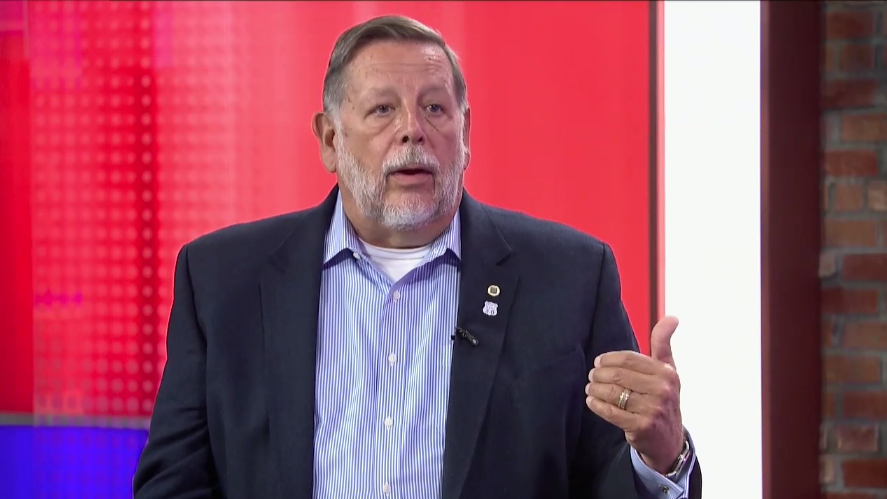Monetizing ATSC 3.0 Comes Into Focus During NAB Show NY ‘Fireside Chat’
Sinclair’s Mark Aitken and BitPath’s John Hane talked NextGen TV opportunities

NEW YORK—With the seemingly endless string of ATSC 3.0 announcements regarding technological advancements, markets launched and partnerships made, it’s easy at times to lose sight of the fact that at the core of it all is the audience—reaching it, serving it in all manner of new and better ways and ultimately monetizing it so that this massive effort proves to be worthwhile.
John Hane, president of BitPath, and Mark Aitken, senior vice president of Advanced Technology for the Sinclair Broadcast Group, focused on how the new broadcast standard is being prepped and positioned to deliver a better product and make the cash registers ring during their “Fireside Chat: Accelerating Change & The Case For NextGen TV” on Oct. 21, part of the TV2025 Monetizing the Future track at the virtual NAB Show New York conference.
“You know [Sinclair/ONE Media] has been engaged in this … for a long time. But now it’s becoming very real. We’ve got deployments under way ... tied to a very real expectation of monetizing not based on the fact that it is great technology but based upon the technology’s ability to grab a hold of new audience segments and revitalize the industry,” said Aitken.
The session, which more or less was a Q&A with Hane serving as the questioner, focused on how ATSC 3.0 as a delivery vehicle for IP data—as opposed to data wrapped in the MPEG-TS container format—brings broadcast into the mainstream of data flows, which in turn creates a variety of new opportunities for broadcasters and audience members alike.
For example, Sinclair last week took delivery of the first production samples of its Mark One ATSC 3.0-enabled smartphone, which will make it possible for broadcasters to reach audiences outside their homes and to blend linear TV and OTT content in a seamless way.
“We’ve got the first of our broadcast-enabled smartphones,” Aitken said as he held a Mark One smartphone for viewers to see.
Pointing out that the phone is not a finished product, Aitken said these sorts of devices fundamentally transform broadcasting. “You add on top of a device like this, which becomes a television much more than a phone … all that internet kind of interactivity that draws people in [and] engages people,” he said.
The professional video industry's #1 source for news, trends and product and tech information. Sign up below.
Not only does ATSC 3.0 become an application environment riding on a wireless IP platform, but also it redefines how broadcasters and viewers connect, he said.
“… [I]t’s a real game changer in terms of where we meet our viewers, where we meet people who consume that data. And that data ... you know, is broadcast out but it’s also our OTT content that gets published to the web first on the part of a broadcast station today. That gets tied together almost seamlessly. For the consumer it is seamless, right?” said Aitken.
PLUS: ATSC 3.0 Offers Broadcasters Substantial Revenue Growth Opportunities, Says Ducey
Hane added that the two-way connectivity supported in 3.0 and integral to the new Mark One smartphone also positions broadcasters to compete with digital media that from the get-go has had a back channel.
“I think about this all the time, Mark, as I watch broadcast: How would you realistically compete today? Over the longer term, right? If you have no direct data from the viewers, from the consumers. It’s almost incomprehensible,” said Hane, who added that back channel data can help guide programming and budgeting decisions and inform broadcasters and marketers alike about changing things such as placement. “I mean [at the moment], our return path is Nielsen.”
Traditionally, television is simply that thing hanging on the wall, but with the advent of NextGen TV and ATSC 3.0-enabled smartphones, the industry will transition from counting TV households to impressions, said Aitken.
“You move to an environment where you have a one-on-one relationship with individuals,” he said. “It’s individuals—and specifically different individuals—and the ability to personalize both in terms of real-time content, [and] as you said you’ve got a measurement media that says … how is that audience moving.”
The ability to personalize the television experience also will drive innovation in quarters outside of broadcasting. “Now is the time to open up the innovators’ paradigm,” said Aitken.
Just as Android apps are available from the Google Store and iOS apps from the Apple Store, broadcast apps should be available from a broadcast store, he said.
“You are going to have innovators coming in and saying, ‘Oh, wow, we’ve never had one-to-many [broadcasting before]. We’ve never had the ability to reach everybody at once with a device that’s got a return channel,’” said Aitken.
Hane interjected that he has a similar vision for BitPath. “We can create APIs, and we can transmit data. And we can allow third-party app developers to access that data and collect subscription revenue for us and remit a portion of it over,” said Hane.
The discussion concluded with how Sinclair has already begun upgrading the experience of TV viewers with 3.0 deployments around the country. Aitken laid out the first of the enhancements to reach viewers, including: transmitting a robust tier of data to deliver linear television, which makes easy for OTA viewers to receive service; high dynamic range (HDR) programming to enhance the visual experience; and the availability of a broadcast app that melds broadcast, OTT and the internet, making it simple for viewers to navigate the hybrid service. “These are exciting times, you know,” said Aitken.
Phil Kurz is a contributing editor to TV Tech. He has written about TV and video technology for more than 30 years and served as editor of three leading industry magazines. He earned a Bachelor of Journalism and a Master’s Degree in Journalism from the University of Missouri-Columbia School of Journalism.

